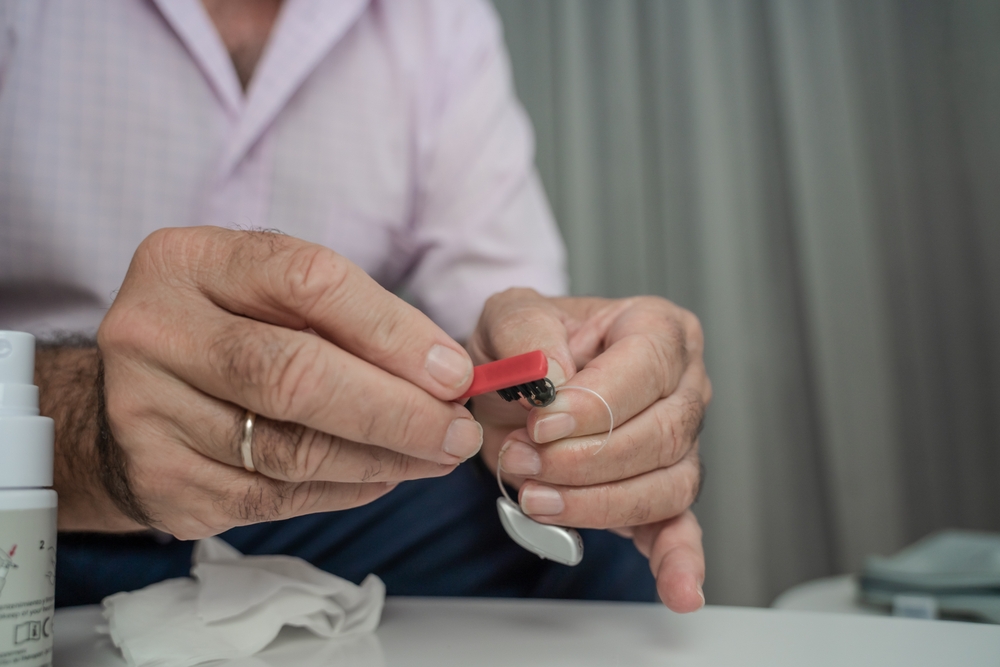
After you have become accustomed to wearing your hearing aid, it becomes a critical element of your everyday routine. The idea of it breaking down can be challenging, not only because of the inconvenience but also due to the potential expense of repairs or replacements.
Tips for maintaining and optimizing your hearing aid performance
By recognizing the prospective threats that can harm your hearing aid and taking measures to maintain it properly, you can preserve its performance and continue to appreciate the improved quality of life it offers.
Effective upkeep of batteries
Your hearing aid’s functionality is highly dependent on its battery. Thus, it is important to pick the appropriate batteries for your device. Discuss with your audiologist to find out which battery type is most suitable for your specific hearing aid model.
It is just as significant to handle the batteries carefully. Oils, dirt, and moisture from your hands can contaminate the batteries, resulting in potential damage.
Always wash your hands before changing the battery, and make sure they are completely dried to prevent introducing moisture into the device.
Adhere to the manufacturer’s guidelines meticulously, especially regarding battery care. Turn off your hearing aid when it’s not being used to preserve battery life and store it in a secure , dry place. Familiarizing yourself with the battery’s normal lifespan is also beneficial.
Mark on your calendar when you replace the battery, so you can prepare for when it needs to be switched out. It’s important to have a spare battery with you at all times, specifically when you are not at home, in order to prevent being stuck without power unexpectedly.
Minimize the risk of moisture damage
As electronic technology, hearing aids are susceptible to moisture. Even nominal exposure can result in damage or a complete breakdown of the device. Safeguard your hearing aid’s functionality by acquiring a specialized drying device to preserve its functionality by removing moisture. This unit supplies a secure and dry environment for your hearing aid when not in use, safeguarding it from damage caused by unwanted moisture.
When participating in physical activities that cause sweating, you may think about removing your hearing aid to stop moisture damage. Consult taking off your hearing aid to exercise, especially outdoors, with your hearing specialist, as doing so may compromise your safety by reducing your awareness of essential auditory cues, such as traffic noises or warning alarms. If possible, opt to work out indoors where it is safer to remove your hearing aid, and make sure to remove your device before showering or swimming.
Furthermore, it is suggested to refrain from using spray deodorants, hairspray, and any other aerosol products when your hearing aid is in your ear. Extended exposure to these products can lead to harm to the device, as the moisture and chemicals they contain can accumulate and result in lasting deterioration over time. Apply these products before putting on your hearing aid to minimize exposure.
Control earwax buildup
While earwax serves as a natural barrier, shielding your ears from debris, dirt, and tiny insects, it can also interfere with the proper functioning of your hearing aid. The accumulation of earwax in the device can lead to it not functioning properly. To control this, have your ears examined by your hearing specialist or physician to evaluate the level of earwax buildup and create an appropriate cleaning routine for both your ears and your hearing aid.
It is necessary to clean your ears carefully and never put anything foreign into your ear canal. Instead, allow warm water to stream into your ears during showers, which can help break up and flush away some of the wax. Routine professional ear cleaning is also advisable. While this may seem inconvenient, it’s much less problematic than dealing with a malfunctioning hearing aid dued to excessive earwax.
To properly clean your hearing aid, carefully adhere to the guidelines provided by the manufacturer.
Different types of hearing aids may require different cleaning techniques, and using the wrong method could cause harm to your device. If you’re unsure about the proper cleaning method, consult your hearing specialist or hearing aid provider to ensure you’re taking the correct steps to protect your device from earwax damage.
Easy methods to ensure lasting reliability
Once you get used to using your hearing aids, they become a crucial aspect of your daily routine, making it difficult to picture life without them. By taking a few simple safety measures, you can avoid damage and ensure your hearing aids remain reliable for years to come. Routine upkeep, proper storage, and careful handling are key to keeping your hearing aids in optimum condition, allowing you to keep enjoying the improved quality of life they supply.
Make an appointment if you’re experiencing issues with your hearing aid or need to schedule a regular maintenance appointment.